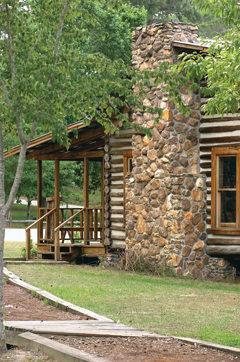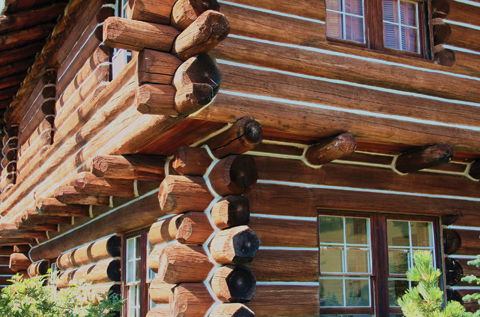For those familiar with log homes, the terms “chinking” and “sealing” are fairly familiar. At some point, most any discussion of construction and maintenance will at least touch on these topics.
“In Old English, the term ‘chinking’ meant to close a fissure or gap,” explains Nadia O’Hara, advertising manager of Perma-Chink Systems. “The process of chinking involved the installation of various materials over the horizontal voids between log courses to prevent air and water from entering the home. Prior to the invention of flexible chinking compound, most log homes were chinked with mud or concrete. Since dried mud and concrete crack as logs expand and contract, log homes had to be rechinked every year.”
Today, the term “chinking” applies interchangeably to the process and to the product being used. To pass muster, a modern chinking compound must adhere well to wood, last for years, and complement the overall look of the home.
“Materials today are generally called polymers, and they look and feel like cement,” relates Bob Kren, president of New Jersey-based Blairstown Distributors. “They move with the logs as they absorb moisture. Think about preventing all the precursors to rot and all that is connected with water—mold, mildew, and especially funguses that get in there.”
The practical aspect of chinking, the protection of the log home’s structural integrity, is complemented by the aesthetic qualities. Chinking is often prominent on a log home and can actually enhance its beauty and appeal.
“With certain types of log homes that have chink relief profiles, the product is used for cosmetic purposes,” explains Kathy Webb, president of Twin Creeks Log Home Supply, Inc., in Johnson City, Tennessee. “In my area, we sell a flat log, and out west you will see round, large handcrafted logs that actually use a strip between the logs. In those cases, the chinking is more for insulation purposes.”
In many cases, chinking serves as a basic preventive measure, helping to preserve logs and their good looks. “In addition to preventing air, insects, and water from getting in a home, synthetic chinking will significantly reduce the susceptibility of the logs to rot and insect damage by preventing water intrusion into wall cavities,” says O’Hara. “Chinking can be anywhere from half an inch to several inches wide. In some types of log home designs it is common for the chinking to account for up to 50 percent of the wall surface.”
 Dan Patrick Photography
Dan Patrick Photography“The term ‘sealing’ means a lot of different things to different people,” comments Kren, “but to me it means the bottom line thing for log homes: to keep water out. All logs shrink, check, and crack around their diameter, and a 14-inch log can one day become a 13.25-inch log. Then, logs can become a reservoir for water.”
Kren recommends the use of an EPA-registered, penetrating oil. He is against the use of caulk to completely seal the surface of a log, since water that is already in the log can establish a “greenhouse effect” if the surface is completely sealed. Liberal use of caulk, he says, can make the house look “like a zebra.”
A variety of sealing products, ranging from oil-based liquids to caulk and other products that may be applied from a tube, are available today. “Cracks may occur between the logs of chinkless or milled homes,” relates O’Hara. “We realize that milled log homes will have some cracking and leakage because of the natural dynamics of the logs. Flexible, water-resistant sealants are available in a variety of colors to blend or contrast with the logs, and these products may last 30 to 40 years.”
Caulking does have its place, however. “Definitely, caulking can be used effectively around narrow joints, windows, and doors to seal an area where the owner wants it to blend in and there isn’t as much visibility,” offers Webb. “If you have air infiltration, you can get water into the house, and that can cause stains and eventual rot, and when the home is sealed properly, especially in the winter, it is more economical to heat and cool.”
The combination of chinking, sealing, and vigilance is essential to protecting your investment and keeping your log home looking great for years. Your log home producer can help you decide which products will be best to keep your log home in great shape.

